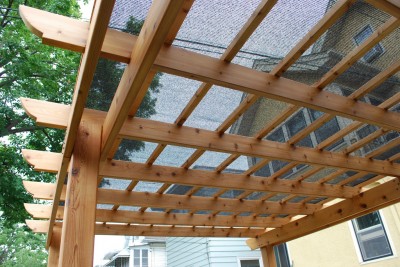






It’s common knowledge that many plants need shade to protect them from bright sunlight. However, savvy gardeners also use shade cover for certain plants to avoid winter burn, also known as sunscald. This article will help with providing shade cover for plants.
Using shade cloth in gardens is a great way to provide shade for plants. Shade cloth comes in a variety of materials of different weights, strengths and colors, including UV-stabilized polyethylene covers, aluminum shade cloth and netting. All are available in most garden centers.
For vegetable gardens planted in rows, you can use floating row covers made of garden fabric. The shade cover material is lightweight and safe to drape directly over plants such as carrots or cabbage. For plants such as tomatoes or peppers, you can purchase support hoops to hold the cover above the plants.
If you’re on a budget, you can create a simple screen with white sheets. Install wooden stakes strategically, placing the screen where it protects the plants from direct sun, then staple the sheets to the stakes. You can place the sheet directly over the plants, but arrange the stakes so the sheet is suspended several inches above the plant.
Other shade cover ideas include old window screens or sheets of lattice, which can be propped or staked on the south or southwest side of the plants.
Sunscald, which primarily affects evergreens, is a type of sunburn that occurs on dry, windy, sunny winter days when plants are unable to draw water from dry or frozen soil. Damage can occur in the winter, but sunscald is often seen when plants are emerging from dormancy in early spring.
Covering evergreens isn’t recommended because the cover can trap winter sunlight and create even more dehydration. However, you can protect evergreens by placing screens made of burlap sheeting on the south and southwest sides of the evergreens.
Install wooden stakes in the ground before the ground freezes in autumn, then staple burlap to the stakes to create a screen. Allow at least 12 inches from the screen and the plant. If possible, the screens should be slightly higher than the plants. If this isn’t possible, protecting the base of the plants can be very helpful.
Alternatively, some gardeners opt for a reflective tree wrap, which may be a better option.
Organic Gardening Ideas To Maximize Your Gardens Potential
Simple Tips That Yield Healthy, Productive Gardens
Tips On Using Your Green Thumb In Organic Gardening
Tips for Creating Garden Design Ideas
Landscaping Ideas To Hide Utility Boxes: Tips On Hiding Utility Boxes With Plants
Copyright © www.100flowers.win Botanic Garden All Rights Reserved